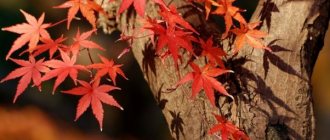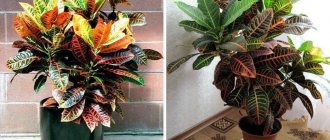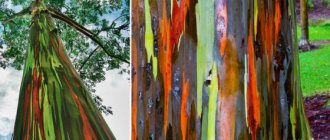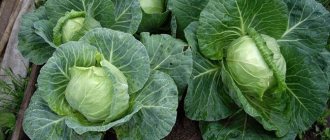Home » Indoor plants » Decorative foliage plants
Published: 10/31/2018
Codiaeum belongs to the Euphorbiaceae family. Native to East India, Malaysia, Sunda and Molluk Islands. Its peculiarity is the presence of milky juice, which soaks the stems and leaves, helping the plant heal any damage and infections. Flower growers often use another name - croton.
- 1 Description
- 2 Varieties for indoor breeding - table
- 3 Home care 3.1 Seasonal table
- 3.2 Transplantation: pot, soil, step-by-step description
- 3.3 Formation, support
Varieties for indoor breeding - table
At home, of the entire species diversity of croton, only one is grown - verigate (variegated), but the varieties bred on its basis are not inferior in color originality.
| Varieties | Leaves and other features |
| Variegatum | Large, length - 30 cm. A variety of shapes of leaf plates from a yellow-green color scheme, varying depending on lighting and other factors. The stem is straight, without foliage below. This is the founder of all decorative hybrids. In the house it grows up to 70 cm. |
| Petra | Thick, shiny, light green in color with yellow edges and veins. The shape is similar to pointed blades. The stem is branched. |
| Tamara | Elongated oval with uneven edges, unusual coloring - pink, purple or yellow spots are scattered on a white-green background. Hybrid. It reaches a height of one meter. Rare variety. |
| Mammy | Twisted, long, curly, variegated in color. |
| Mrs Eyeston | Long, wide, rounded at the ends, brightly colored - yellow, red, pink and gold. Tall tree variety |
| Black Prince | So dark green that they appear black. Red, yellow, and orange spots are scattered on wide dark ovals. |
| Excellent | They resemble oak trees, the front side is yellow-green, the back is burgundy-red. Low bush. |
| Disraeli | Lobed green, veins yellow, bottom brick-brown. |
| Zanzibar | Very narrow and long, falling like a green, yellow, red waterfall. Looks impressive in hanging baskets. |
| Aucubifolia | Small narrow, green with yellow uneven splashes. |
| Sunny Star | Narrow, dark green, blooming at the tips with yellow and lemon hues. |
| Three-cavity | Consist of three parts with gold veins. |
| Eburnaeum (white chimera) | Creamy shade. With bright diffused lighting and constant spraying, it can please you with burgundy colors. |
| Splashes of champagne | Narrow oblong, dark with yellow splashes. |
The mix is a varietal variety of croton.
Brief description of the flower
The perennial deciduous plant codiaum belongs to the Euphorbiaceae family. Botanists consider it a mistake to call these flowers crotons, as they belong to a separate genus Codiaum.
Codiaum is in great demand in indoor floriculture.
In general, codium croton of any type has a similar description:
- can grow in the form of a bush and tree;
- has a flexible and strong trunk;
- rarely opens buds, since flowering is not typical for this plant - in this way it reacts to the stress experienced after a long drought or waterlogged soil;
- The leaves are variegated and dense in texture and have a smooth surface.
Important! Croton juice is poisonous and can cause severe allergies and even vomiting.
Home care
The plant is quite finicky, but if you create the right conditions, you can achieve diversity and brightness throughout the year.
Seasonal table
| Parameter | Spring Summer | Autumn winter |
| Location/Lighting | Prefers eastern and western windows with bright but diffused lighting. | It is best to choose a south window. With light starvation, the leaves will begin to lose their bright color; lighting is necessary. |
| Temperature | Comfortable - +20…+24℃. At +30℃, shading and increased humidity are necessary. | Avoid temperature changes. Acceptable - +18…+20℃, not lower than +16℃. |
| Humidity | Increased. In summer, constant spraying with warm, settled water. It is good to place the container with the flower in a flowerpot with a damp filling (pebbles, expanded clay). | Spraying is reduced. But during the heating season, it is necessary to monitor the saturation of moisture in the air near the codiaum. |
| Watering | Frequent, good. But the soil should dry out to a third of the container. The water is warm and settled. | Reduce. |
| Feeding | Once a week - alternating complex mineral and organic fertilizers | Reduced - 1 time per month. |
Transplantation: pot, soil, step-by-step description
Codium is transplanted in the spring. Young (1-3 years) - annually, adults (over 3 years) - once every 2-4 years.
The pot should be shallow, slightly wider than the container in which the flower was before transplanting. Since its roots grow, they interfere with the development of foliage. For young croton, you can use plastic, but for older croton, a clay ceramic pot is preferable so that the soil inside can breathe.
Drain holes are required.
The soil needs to be slightly acidic. The finished universal soil is diluted with fine-grained drainage, perlite and charcoal. Self-cooking:
- young growth: humus, turf, coarse sand (2:1:1);
- adult croton - (3:1:1).
Transplantation is a step-by-step process:
- The soil is pre-watered.
- The new container is filled with drainage (three centimeters) and a small amount of soil mixture.
- Using the transshipment method, they take out the codiaum, place it in the middle and add soil.
- Watered.
- Place the flower pot in a place with sunny but diffuse lighting. Moisturize daily.
It is better to replant a new flower after a month.
To improve the adaptation process, croton is sprayed with a growth stimulator (Epin).
Formation, support
To create a more luxuriant crown, young plants are pinched. At the beginning, 15 cm, as it grows - 20 cm. Pruning is carried out in the spring.
If after the procedure the codiaum stops growing, this is a temporary phenomenon. After some time it will branch.
For an adult croton, with a lot of foliage and an insufficiently strong trunk, support is needed. In the beginning, you can use bamboo or wooden sticks. You can also purchase special devices for vines, or make them yourself.
Hydration
Watering the plant should be moderate. The soil should be slightly moist, but without stagnation of moisture at the roots. For watering you need settled, soft, warm water. Settling can be replaced by filtration.
The moistening process should include daily spraying and wiping the leaves on both sides. Croton is a moisture-loving plant; it should not be placed near heaters.
Errors in care and their elimination - table
Croton's appearance will indicate improper conditions of detention and mistakes in caring for it.
| Type of lesion | Reason for appearance | Elimination method |
| The foliage is turning pale. | Lack of lighting. | Place close to the light, but protect from bright sunlight. In winter, use artificial lighting. |
| Dry brown specks. | Sunburn. | Hide from sunlight. |
| The leaves are curled, the ends are brown but soft. | Temperature changes. | Monitor the temperature during the day and at night. It shouldn't be drastically different. |
| Brown and brown edges of leaves. | Lack of watering. Dry air. Drafts. | Provide everything:
|
| Drooping leaves, loss of elasticity. | Lack of watering. Freezing of roots. | Water regularly with warm water. Place in a bright and warm room. |
| Leaf fall. | Croton is getting old. Excess moisture in winter. Very dry or cold atmosphere, drafty. | Follow the codeum: With normal growth of young leaves, this is a common occurrence. If young growth is suffering, eliminate all shortcomings. |
| Redness of the leaves. | Nitrogen starvation. | Use fertilizers containing nitrogen. |
| The back of the leaf becomes white and fluffy, the top becomes brown. | Temperature too low. Overwatering. | In winter, if there is a lack of heat, water with warm water after the soil has dried to one third of the volume of the pot. |
| Yellowing. | Lack of nutrition. Overwatering. | Apply fertilizer as it grows. Follow watering rules. |
| Red spots on the back of leaves. | Excess sun. | Shade in midday sun. |
Features of caring for croton
The culture requires access to bright sunlight; in the morning and evening, you can expose the croton flower to direct rays. In summer, the most suitable place for a flower is a north-facing window, and in winter, a south-facing window.
It is beneficial for the bush to be in the fresh air in the summer in an area of diffused sunlight. When there is insufficient light, the leaves become uniformly green. The temperature regime for good growth in summer is 22 degrees, in winter - at least 16 degrees.
Diseases, pests - table
| Manifestation | Disease, pest | Fighting method |
| The appearance of brown spots. Codiaum does not grow and dries out over time. | Fungal disease | Remove diseased leaves. Place the codiaum in a weak solution of potassium permanganate. Replace the soil. Treat Croton with Fitosporin solution. In case of severe damage, use Speed. |
| Yellowing and falling leaves, softening of roots. | Root rot | Only at the beginning of the disease is it possible to save croton:
Protected light and infrequent watering are required until new leaves appear. |
| The appearance of yellow spots, white cobwebs. The leaves are withering. | Spider mite | Remove diseased leaves. Spray with Fitoverm, Actellik. |
| Convex, dark spots on the back of the leaf. | Shchitovka | Remove the pest. Spray with Actellik. Repeated treatment until the insect disappears. |
| The leaves are sticky, a whitish coating appears, and growth stops. | Mealybug | Treat with insecticide repeatedly. |
Croton propagation methods
The plant can be propagated by seeds, stems and leaf petioles. Only fresh seeds are suitable for planting. Germination occurs over a long period.
It is much easier to cut cuttings from the stem so that each of them has a healthy leaf and internode. The sections become covered with milky juice, it must be washed off, and the sections must be dried in the fresh air. Then the parts are placed in jars of water and illuminated. When roots about 2 cm in size appear, the new plant is planted in pots.
Description and homeland of the plant
Croton is popularly called the plant Codium variegated. The flower is a representative of the genus Codium from the Euphorbiaceae family. It is an evergreen perennial grown as a compact bush or tree. Croton leaf blades can have different shapes - ovoid, ribbon-shaped (including twisted), heart-shaped, oval, three-fingered.
A common feature of all variegated codiaums is the special color of the leaves, on “aged” specimens of which veins and spots of colors from yellow, red to brown and even black appear. All year round they look very impressive and attractive.
When grown at home, the crop rarely blooms. Since peduncles do not have decorative value, but at the same time excessively weaken the plant, they are usually removed immediately if you do not want to get seeds from it yourself. You should know that during seed propagation, varietal characteristics are not preserved.
Croton is native to a wide range that includes many Asian countries, including India and Malaysia, as well as the islands of Oceania and northern Australia. In its natural environment, the plant can take the form of a shrub or a low tree, in both cases occupying a place in the partial shade of other, taller crops.
When growing a croton flower at home, you should keep in mind that its milky sap is poisonous. You can place the plant where children and pets do not have access to it.
Trimming
Probably every owner of Codieum sets the goal of growing a beautiful bush with an evenly leafy crown. This can be achieved by pruning. Formation begins in the spring. In a young plant, it will be enough to pinch the top; this procedure causes branching. In an old plant, the crown is formed by pruning shoots and removing excess branches.
To prevent fungal diseases, the cut area should be sprinkled with crushed coal. Cut branches are used for cuttings. Different varieties need to be pruned based on their characteristics. Codiaum Petra does not branch too much so that a beautiful lush bush grows; several pieces of future beauties can be planted in one pot.
Garden varieties
In an ordinary garden, the tropical alien codiaum does not survive - the heat-loving plant does not have enough strength to survive the winter even in the southern regions of our country. However, in closed winter gardens and greenhouses it is possible to create conditions suitable for the croton plant - warmth all year round, plenty of light and high humidity.
As with home cultivation, only the variegated codiaum species is suitable for greenhouses - it is the most unpretentious and least demanding of care. The variety of its varieties will help you choose the one that you like the most and will delight the eye throughout all seasons of the year.
Propagation of codiaum using cuttings
With this method of propagation, a lot will depend on the chosen cutting itself; you need to decide which part of the plant to take the cuttings from and what time to choose for this.
All months are suitable for propagation, with the exception of January-February, since this is the resting time for the plant. Rooting of cuttings during this period will be weak, or may not occur at all.
The best time to root cuttings, of course, is spring.
Suitable cuttings:
- apical shoots with an active bud;
- stem shoots with one leaf;
- You can use the woody part of the plant without buds at all.
In general, you can use almost any part of the plant. The main condition is the correct cutting of the cuttings themselves.
Each of them must have:
- length - 6-12 centimeters, no less;
- thickness - 7-8 millimeters;
- or at least one leaf, and for apical shoots - a couple of leaves, so that they take root better.
You need to examine the plant and identify those shoots that can be used for cuttings.
Codiaum is a poisonous plant, but the poison is contained only in the sap of the plant. It can cause an allergic reaction and even a burn on the skin.
Therefore, all cutting work should be carried out only with gloves, and then wash your hands with soap after fiddling with the flower.
Stages
Having decided to start cuttings and choosing a suitable mother plant:
- determine the shoot in order to cut the apical part. In addition, stem shoots are selected that are suitable for obtaining several cuttings.
- The cuttings are carefully cut off and laid out on paper so as not to confuse where the top is (for those that do not have a crown)
- The cuttings should be kept in warm water for several minutes to allow the milky juice to drain. Afterwards, you can lightly treat it with wood ash so that the juice does not stand out.
- 1-2 leaves are left on each cutting for adequate nutrition and faster rooting. To better retain moisture, the leaves are sometimes tied and rolled into a tube, which helps retain water in the leaf.
- Cuttings on cuttings must be kept in the air to dry, and then treated with a root growth stimulator (root or zircon). Thanks to these preparations, not only does the root system form better, but the cuttings are also saturated with useful microelements, which are so necessary during establishment;
- Rooting is carried out either in prepared soil or in water. When rooting in the substrate, you need to cover the cutting with a jar or plastic bottle. You can also make a small greenhouse out of film. But in any case, we must not forget about daily ventilation of the shelter.
- When rooting in water, you need to monitor the temperature and quality of water in the jar with the shoots. A healthy and powerful root system will be ensured by maintaining the water temperature from 24 to 30 degrees.
If all necessary conditions are properly met, the roots begin to germinate in three to four weeks.
Main varieties of croton
The genus Codiaum includes a little more than 15 species. However, breeders have developed dozens of new hybrids that differ in the shape and size of the plant, its foliage, and color palette.
The principles of caring for all of them are almost the same: natives of the tropics love warmth, light and high humidity. The diversity of cultural types can be judged by the photos below with their names and descriptions.
Dragon look
Adult specimens are croton trees with a strong trunk. Their resin is used in folk medicine in South America as an antiviral drug and anesthetic. Due to its red color it is called "dragon's blood". This substance is also used in paint and varnish production.
Cascarilla or Eutheria
In its native environment, this type of codiaum grows as a shrub or not very tall tree. The leaves are broadly ovate, with a finely toothed edge. The flowers have a pleasant aroma.
The bark of Codium Cascarilla (the roots of the name are Spanish, translated as “bark”) is valued most as a pharmaceutical raw material. It is also used to make cascarilla oil and a flavoring for liqueurs.
Both in the natural environment and in the photo, Codiaum Cascarilla looks impressive, but it is not grown indoors.
spiny
A related species to dragon codium, it is also widely used in the production of varnishes. Its homeland is the countries of South America. Not cultivated as a houseplant.
Laxative
This is the type species of the genus Croton. Habitat: India, Sri Lanka, Malaysia. It is also cultivated in China, Zanzibar, and Java. A fatty oil is obtained from the seeds of the flower, which not only has a strong laxative property, but is also poisonous (20 drops of it are already lethal). If it comes into contact with the skin, it causes severe inflammation. Not common as a houseplant.
Motley
The only type of codiaum grown as an indoor crop. The plant's homeland is the tropical regions of India and Malaysia. In heated greenhouses it reaches a height of four meters; in a home microclimate it grows to a maximum of 70 cm.











